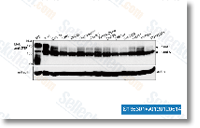Evidently, the inactivation on the p53 and RB1 systems compromises the perform of cell cycle checkpoints responding to telomere erosion, chromosomal instability, and oncogene- induced irregular replication. Furthermore, checkpoint signaling as a result of ATR and CHK protein kinases can be suppressed in these cancers. With each other, these changes could account for the limited result of cytotoxic chemotherapy within the therapy of invasive bladder cancers. They could also be really pertinent to therapies working with novel medication directed at signal transduction pathways. Loss on the p53 and pRB1 management programs may well uncouple proliferation within the tumor cells from extracellular signals, diminishing the requirement for signaling by way of these pathways.
Tellingly, signatures within the overactive transcription components E2F1 or E2F3, that are typically restrained by RB1 from driving cell proliferation and replication, dominate selelck kinase inhibitor the expression profiles of invasive bladder cancers and distinguish them from papillary tumors. The assortment of genetic modifications observed in invasive urothelial carcinomas is just like that encountered in other carcinomas, such as lung cancers and squamous cell carcinomas. Using the anticipated variations, the theme emerging through the comparison of papillary and invasive bladder cancers might for this reason be pertinent from the pathogenesis of those cancers at the same time. As an illustration, the limited efficacy of small-molecule EGF receptor inhibitors in lung cancers and metastatic colorectal carci- nomas could be triggered not only by downstream mutations in signal transduction pathways, but additionally by an analogous uncoupling of cell cycle progression and cell proliferation from pathways driven by growth issue receptors by p53 mutations and RB1 inactivation.
Conclusions Primary mechanisms driving cancer growth regularly recur in different cancer varieties, but much more regularly than not with variations which have ramifications that lengthen beyond heuristics for the layout of novel therapeutic approaches. Countless new issues stick to through the insights sketched above.
For instanselleck chemical ce, which mechanisms trigger the constitutive activation of your hypoxic response in ccRCC scenarios  lacking VHL mutations Are these much more just like those mediating adaptation to hypoxia in other cancer forms Which targets from the epigenetic repression elicited by EZH2 deregulation in prostate cancers are vital for pathogenesis and accessible to therapeutic approaches How can urothelial cancers with overactive signal transduction pathways be reliably distinguished from individuals with failure of your central p53 and RB1 handle programs in clinical practice, and which molecular targets for treatment can be picked in cancers largely independent of extracellular signaling pathways The ways for genomic analyses that have been available within the previous decade have aided to define these questions and the new generation of methods really should support to answer them, hopefully soon.
lacking VHL mutations Are these much more just like those mediating adaptation to hypoxia in other cancer forms Which targets from the epigenetic repression elicited by EZH2 deregulation in prostate cancers are vital for pathogenesis and accessible to therapeutic approaches How can urothelial cancers with overactive signal transduction pathways be reliably distinguished from individuals with failure of your central p53 and RB1 handle programs in clinical practice, and which molecular targets for treatment can be picked in cancers largely independent of extracellular signaling pathways The ways for genomic analyses that have been available within the previous decade have aided to define these questions and the new generation of methods really should support to answer them, hopefully soon.
PCNA signal
PCNA is a member of the so called DNA
